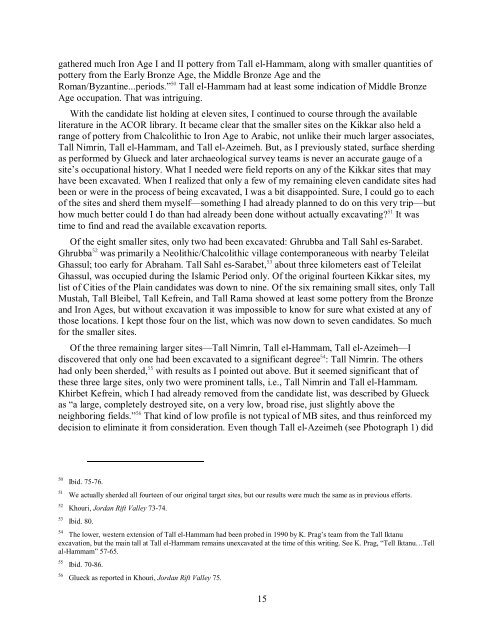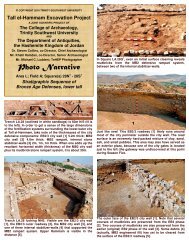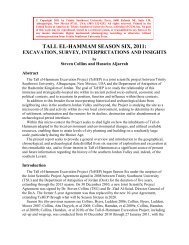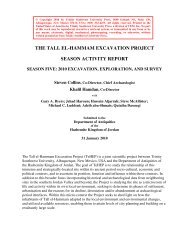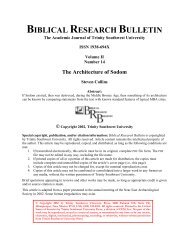Explorations on the - Tall el-Hammam Excavation Project, Jordan
Explorations on the - Tall el-Hammam Excavation Project, Jordan
Explorations on the - Tall el-Hammam Excavation Project, Jordan
You also want an ePaper? Increase the reach of your titles
YUMPU automatically turns print PDFs into web optimized ePapers that Google loves.
ga<strong>the</strong>red much Ir<strong>on</strong> Age I and II pottery from <strong>Tall</strong> <strong>el</strong>-<strong>Hammam</strong>, al<strong>on</strong>g with smaller quantities of<br />
pottery from <strong>the</strong> Early Br<strong>on</strong>ze Age, <strong>the</strong> Middle Br<strong>on</strong>ze Age and <strong>the</strong><br />
Roman/Byzantine...periods.” 50 <strong>Tall</strong> <strong>el</strong>-<strong>Hammam</strong> had at least some indicati<strong>on</strong> of Middle Br<strong>on</strong>ze<br />
Age occupati<strong>on</strong>. That was intriguing.<br />
With <strong>the</strong> candidate list holding at <strong>el</strong>even sites, I c<strong>on</strong>tinued to course through <strong>the</strong> available<br />
literature in <strong>the</strong> ACOR library. It became clear that <strong>the</strong> smaller sites <strong>on</strong> <strong>the</strong> Kikkar also h<strong>el</strong>d a<br />
range of pottery from Chalcolithic to Ir<strong>on</strong> Age to Arabic, not unlike <strong>the</strong>ir much larger associates,<br />
<strong>Tall</strong> Nimrin, <strong>Tall</strong> <strong>el</strong>-<strong>Hammam</strong>, and <strong>Tall</strong> <strong>el</strong>-Azeimeh. But, as I previously stated, surface sherding<br />
as performed by Glueck and later archaeological survey teams is never an accurate gauge of a<br />
site’s occupati<strong>on</strong>al history. What I needed were fi<strong>el</strong>d reports <strong>on</strong> any of <strong>the</strong> Kikkar sites that may<br />
have been excavated. When I realized that <strong>on</strong>ly a few of my remaining <strong>el</strong>even candidate sites had<br />
been or were in <strong>the</strong> process of being excavated, I was a bit disappointed. Sure, I could go to each<br />
of <strong>the</strong> sites and sherd <strong>the</strong>m mys<strong>el</strong>f—something I had already planned to do <strong>on</strong> this very trip—but<br />
how much better could I do than had already been d<strong>on</strong>e without actually excavating? 51 It was<br />
time to find and read <strong>the</strong> available excavati<strong>on</strong> reports.<br />
Of <strong>the</strong> eight smaller sites, <strong>on</strong>ly two had been excavated: Ghrubba and <strong>Tall</strong> Sahl es-Sarabet.<br />
Ghrubba 52 was primarily a Neolithic/Chalcolithic village c<strong>on</strong>temporaneous with nearby T<strong>el</strong>eilat<br />
Ghassul; too early for Abraham. <strong>Tall</strong> Sahl es-Sarabet, 53 about three kilometers east of T<strong>el</strong>eilat<br />
Ghassul, was occupied during <strong>the</strong> Islamic Period <strong>on</strong>ly. Of <strong>the</strong> original fourteen Kikkar sites, my<br />
list of Cities of <strong>the</strong> Plain candidates was down to nine. Of <strong>the</strong> six remaining small sites, <strong>on</strong>ly <strong>Tall</strong><br />
Mustah, <strong>Tall</strong> Bleib<strong>el</strong>, <strong>Tall</strong> Kefrein, and <strong>Tall</strong> Rama showed at least some pottery from <strong>the</strong> Br<strong>on</strong>ze<br />
and Ir<strong>on</strong> Ages, but without excavati<strong>on</strong> it was impossible to know for sure what existed at any of<br />
those locati<strong>on</strong>s. I kept those four <strong>on</strong> <strong>the</strong> list, which was now down to seven candidates. So much<br />
for <strong>the</strong> smaller sites.<br />
Of <strong>the</strong> three remaining larger sites—<strong>Tall</strong> Nimrin, <strong>Tall</strong> <strong>el</strong>-<strong>Hammam</strong>, <strong>Tall</strong> <strong>el</strong>-Azeimeh—I<br />
discovered that <strong>on</strong>ly <strong>on</strong>e had been excavated to a significant degree 54 : <strong>Tall</strong> Nimrin. The o<strong>the</strong>rs<br />
had <strong>on</strong>ly been sherded, 55 with results as I pointed out above. But it seemed significant that of<br />
<strong>the</strong>se three large sites, <strong>on</strong>ly two were prominent talls, i.e., <strong>Tall</strong> Nimrin and <strong>Tall</strong> <strong>el</strong>-<strong>Hammam</strong>.<br />
Khirbet Kefrein, which I had already removed from <strong>the</strong> candidate list, was described by Glueck<br />
as “a large, complet<strong>el</strong>y destroyed site, <strong>on</strong> a very low, broad rise, just slightly above <strong>the</strong><br />
neighboring fi<strong>el</strong>ds.” 56 That kind of low profile is not typical of MB sites, and thus reinforced my<br />
decisi<strong>on</strong> to <strong>el</strong>iminate it from c<strong>on</strong>siderati<strong>on</strong>. Even though <strong>Tall</strong> <strong>el</strong>-Azeimeh (see Photograph 1) did<br />
50 Ibid. 75-76.<br />
51 We actually sherded all fourteen of our original target sites, but our results were much <strong>the</strong> same as in previous efforts.<br />
52 Khouri, <strong>Jordan</strong> Rift Valley 73-74.<br />
53 Ibid. 80.<br />
54 The lower, western extensi<strong>on</strong> of <strong>Tall</strong> <strong>el</strong>-<strong>Hammam</strong> had been probed in 1990 by K. Prag’s team from <strong>the</strong> <strong>Tall</strong> Iktanu<br />
excavati<strong>on</strong>, but <strong>the</strong> main tall at <strong>Tall</strong> <strong>el</strong>-<strong>Hammam</strong> remains unexcavated at <strong>the</strong> time of this writing. See K. Prag, “T<strong>el</strong>l Iktanu…T<strong>el</strong>l<br />
al-<strong>Hammam</strong>” 57-65.<br />
55 Ibid. 70-86.<br />
56 Glueck as reported in Khouri, <strong>Jordan</strong> Rift Valley 75.<br />
15


